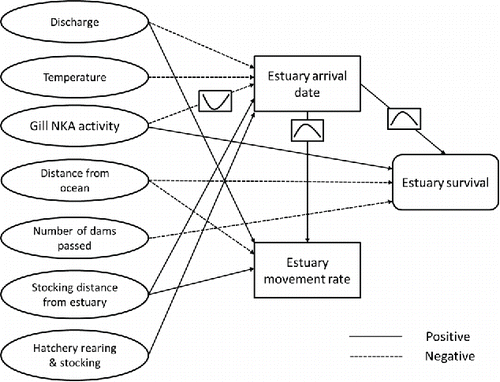Figures & data
FIGURE 1. Map of the Penobscot River watershed in Maine, showing the locations of tributaries, dams, and release sites in the Penobscot River (left panel). The right panel shows the locations of acoustic receivers used to detect Atlantic Salmon smolts in the estuary. Parameters associated with Cormack–Jolly–Seber survival models are as follows: detection probability at each location following release (pt), apparent survival within reaches between locations (φt), and λ11 (product of φ11in the final reach and p11 at the final receiver location). There were 40 receivers in the bay that are not shown. The asterisk indicates the point of virtual release in the estuary for Cormack–Jolly–Seber models.

TABLE 1. Release sites, river kilometer of release sites (rkm), rearing history (Origin), and number of fish used in the study (n; numbers in parentheses indicate the total number of fish originally released in each group) for Atlantic Salmon smolts acoustically tagged and released throughout the Penobscot River and its estuary in 2005–2013; twp. = township. Summary statistics were calculated with only fish that were used in the current study and include the mean (SD in parentheses) of fork length (FL; mm), gill Na+, K+-ATPase (gill NKA) activity (μmol ADP · mg protein−1 · h−1), and mass (g).
TABLE 2. Model-selection statistics for generalized linear models that were used to quantify the relationships between the date of arrival by acoustically tagged Atlantic Salmon smolts in the Penobscot River estuary in 2005–2013 and fish characteristics (rearing history [rearing], gill NKA activity), migratory history (photoperiod at release date [PP], release rkm [release], migratory route through the lower river [SW]), and environmental conditions (accumulated thermal units [ATU], discharge experienced from release to arrival date [discharge]). The number of parameters estimated in each model is k, AIC is the Akaike information criteria for each model, ΔAICc is the difference between the AICc of each model and the best model in the candidate set, and w is the relative probability that each model is the best in the candidate set. Only models with substantial support (ΔAICc < 2.0) are shown.
FIGURE 2. Predictions from the generalized linear model relating arrival date of acoustically tagged Atlantic Salmon smolts in the Penobscot River estuary in 2005–2013 to (a) release rkm (upstream of estuary), (b) discharge experienced from tagging to estuary arrival date, (c) accumulated thermal units experienced prior to release, and (d) gill NKA activity. The black lines indicate means and the dashed gray lines indicate the 95% CIs.
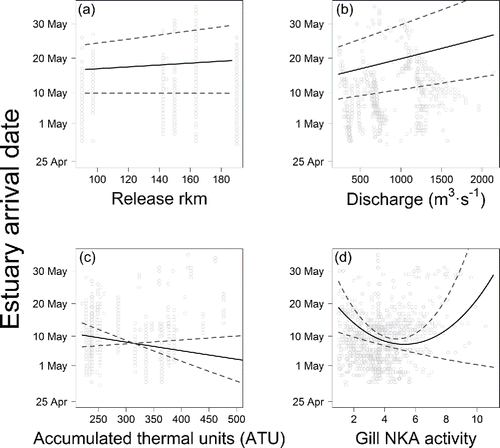
TABLE 3. Standardized regression coefficients, standard error (SE), and 95% confidence limits (CLs) for the generalized linear model used to model estuary arrival date (as a function of photoperiod at release date [PP], release rkm, rearing history, and discharge). Also shown is the linear mixed-effects model used to model movement rates as a function of location (estuary rkm), discharge, release rkm, and photoperiod for date of movement (PP, PP2). Covariate effects were significant at α = 0.05 if the range of the 95% CLs did not overlap 0.
FIGURE 3. Mean (solid line) and 95% CI (dashed lines) predictions from parameters of the generalized linear mixed-effects model used to relate movement rate of acoustically tagged Atlantic Salmon smolts in the Penobscot River estuary in 2005–2013 to (a) photoperiod, (b) location in the estuary (rkm), (c) release distance upstream of the estuary (rkm), and (d) discharge experienced during estuary migration.
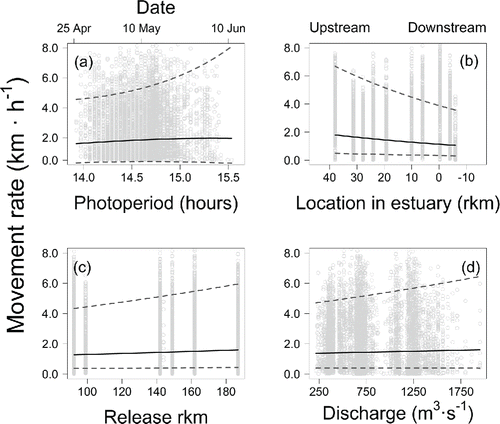
FIGURE 4. Estimates of (a) mean (whiskers indicate 95% CI) detection probability for V9 (white) and V7 (black) acoustic tag models in each reach across years 2005–2013 and (b) mean apparent survival per kilometer of acoustically tagged Atlantic Salmon smolts in the Penobscot River estuary in 2005–2013, estimated using Cormack–Jolly–Seber models. The solid line in each box in panel (b) indicates median annual survival, box-ends indicate the inner quartile range, and whiskers indicate the 95% CI. The box widths are proportional to the estuary reach lengths to which the estimates apply. From left to right, the three divisions in each panel represent freshwater, the zone of transition from low salinity to high salinity, and salt water within the Penobscot River estuary.
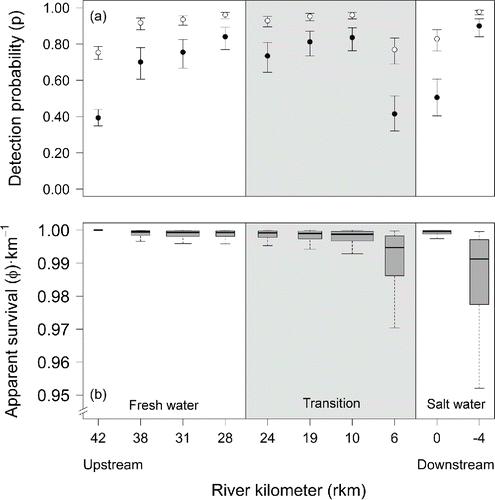
TABLE 4. Standardized regression coefficients (logit) and 95% confidence limits (CLs) for individual covariates included in the top-ranked Cormack–Jolly–Seber mark–recapture model used to estimate apparent survival (φ) and detection probability (p) of acoustically tagged Atlantic Salmon smolts during emigration through the Penobscot River estuary in 2005–2013. Tag type was classified as a binary covariate: smaller (V7) tags were assigned to 0 and larger (V9) acoustic tags were assigned to 1. The abbreviations PP and PP2 indicate photoperiod for the date of movement. Covariate effects were significant at α = 0.05 if the range of the 95% CLs did not overlap 0.
FIGURE 5. Means (solid line) and 95% CIs (dashed lines) of predictions from parameters of the Cormack–Jolly–Seber mark–recapture models used to estimate apparent survival (φ) of acoustically tagged Atlantic Salmon smolts through the Penobscot River estuary in 2005–2013. The panels show the effects of (a) individual timing, (b) number of dams passed by individuals, and (c) gill NKA activity of individuals on estimated survival.
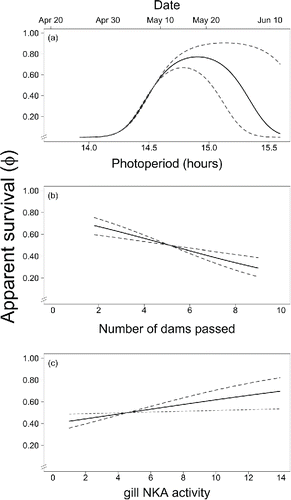
TABLE 5. Model-selection statistics for Cormack–Jolly–Seber mark–recapture models used to estimate survival of acoustically tagged Atlantic Salmon smolts during emigration through the Penobscot River estuary in 2005–2013 and to test hypotheses about fish characteristics and migratory history that influenced survival. Table headings and model-selection statistics are defined as in Table 2, except here we used quasi-Akaike information criterion corrected for small sample size (QAICc) for model selection. The top 10 candidate models are shown. All candidate models in this set included the covariates representing spatial and temporal variation, φ(reach + year + PP + PP2), in addition to the covariates shown in each model below. Covariates of apparent survival (φ) include the gill NKA activity, number of dams passed (dams), median movement rate in the estuary by individual smolts (R), and distance of release from the ocean (release).
FIGURE 6. Diagram synthesizing the major findings about the factors affecting aspects of estuary migration of Atlantic Salmon smolts during the present study. The dotted lines indicate negative relationships, whereas solid lines indicate positive influences. The assumed causality of relationships is indicated by the direction of the arrows. Nonlinear (quadratic) relationships are indicated by the parabolas in boxes on top of the arrows that describe the relationships.
